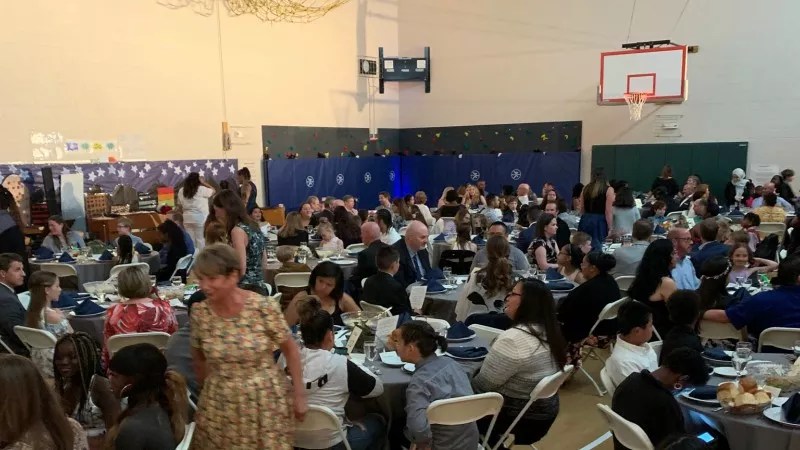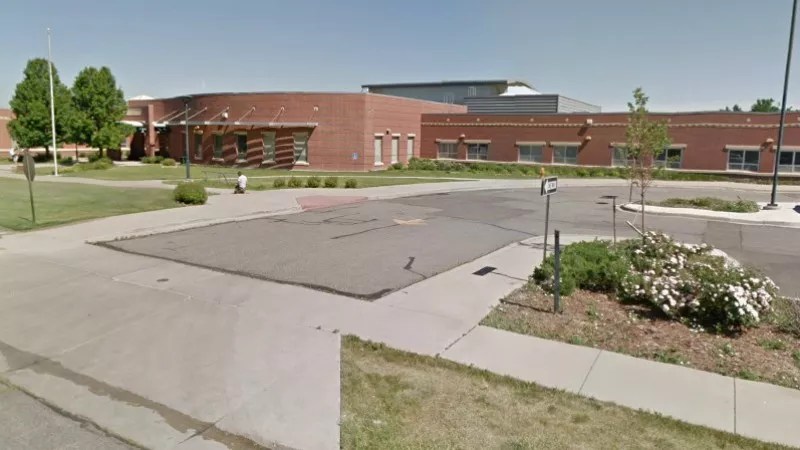
Patricia Vaughan

Audio By Carbonatix
Well over 1,000 students enrolled at Denver Public Schools are homeless. Students who lack a fixed, regular and adequate nighttime residence account for 1 to 2 percent of total DPS attendees, and a considerably higher percentage than that go to Lowry Elementary School, whose proximity to several transitional housing facilities has led the district to permanently assign Homeless Education Network counselor Patricia Vaughan to the campus.
Vaughan has plenty of tools to help kids (and their families) in such challenging circumstances. But one of the most powerful is also highly unusual: a cotillion.
In advance of the annual event (this year’s version took place on May 2), fifth-graders at the school learn the basics of etiquette – and while students of every conceivable economic background attend, Vaughan says the gathering’s impact is particularly profound on those for whom shelter is an everyday concern.
“The whole gym is transformed into this beautiful place to have dinner, and the seats are selected by lottery, so all the families are mixed up,” she notes. “These kids get all dressed up, and it may be one of the few times some of them get to be alone with their parents or guardians, because there are often a lot of kids in the family and they’re having to babysit their younger brothers or sisters. And they learn things that are going to help them make connections with people the rest of their lives. How to make eye contact. How to shake hands. How to hold their fork and knife.”
Over the course of the evening, Vaughan adds, “this magical transformation takes place, and they become young ladies and gentlemen.”
Such moments of normalcy and pride are rare in the lives of homeless children – and that’s why they’re so important to Erik Johnson, DPS executive director of finance, who oversees the district teams that support the Homeless Education Network, as well as programs related to foster care and children of military and migrant families. “No matter how much great work we’re doing, it’s never enough,” he acknowledges. “The more we can do, the better.”

Lowry Elementary School
Google Maps
The scope of the problem is daunting. Official DPS figures from the past three Octobers show 1,085 homeless students enrolled in 2016, 1,021 in 2017 and 1,159 for 2018. But Will Jones, the district’s director of media relations, acknowledges that “these numbers are low,” as indicated by digits tracked throughout the year by the Homeless Education Network. For example, the HEN estimate for the 2017 school year as a whole is 1,762, or 42 percent greater than the October sum.
The federal McKinney-Vento Homeless Assistance Act dictates the definitions for homelessness using four categories: shelter or transitional housing program; motel or hotel (paid or with vouchers); doubled up with a friend or relative due to the loss of housing and economic hardship; and unsheltered – staying in parks, public spaces and abandoned buildings. Included are unaccompanied youth living in one of these situations who aren’t in the physical custody of a parent or legal guardian.
The assistance DPS offers to students and families struggling with these circumstances “depends on the situation,” Johnson notes. “We can provide additional help with things like gas cards when we have a scenario where a child is living temporarily with a grandparent or someone like that outside the district, because we wouldn’t have transportation for that person. Or we’ll work with other agencies to provide additional support. One child last year was living with a relative, and it was costing so much to transport the kid across the city that they’d fallen behind on rent. So we worked with another nonprofit to pay back the past-due rent and provided gas cards going forward. And that’s just one of the heartbreaking scenarios we get into.”
Other benefits mentioned by Johnson include “providing clothes, grocery cards, food bags, backpacks and sometimes even bikes. This year, we had a foster child who had some motor-skill issues who needed an inclusionary bike, so we teamed with an outside organization to get a bike this handicapped child could use. And we have services like buying a cap and gown for graduation, which can be an expensive ordeal.”
This last program has become increasingly important in Denver Public Schools. During the 2006-2007 school year, the graduation rate for homeless students was just 21.9 percent. A decade later, during 2016-2017, the rate had more than doubled, to 45 percent. But it’s still considerably below the overall district graduation rate of 64.8 percent as of 2017-2018.

Patricia Vaughan is a school counselor with the Homeless Education Network.
Counseling tailored directly to kids living in homelessness is also key in Johnson’s view. “I was out doing a visit last year, and one child who was maybe in sixth grade and had done really well got a reward of being able to go out and play with a friend for twenty minutes,” he recalls. “Something this simple can make a big difference when you’re experiencing so much trauma outside the classroom.”
That’s particularly true at Lowry, which Vaughan says has “an unusual population – students who are at the very high end and at the very low end. We have children living in million-dollar houses and children living in a car. And getting into stable housing is a really primary, foundational change for homeless families. I’ve been doing this for fourteen years, and I have students who come back to me who are in their first or second year of college. They’re first-generation college kids, and many times they’ve come from generational poverty, where they don’t have any role models, or they’ve never seen a model of education having done anyone any good. They haven’t seen anybody move up. But now, they’ll be the role model.”
Lowry educators undergo a great deal of training to learn how to best aid homeless students, and Vaughan feels one training is especially effective: “I’ll bring in a bunch of backpacks and a bunch of rocks, and during professional development, the teachers will put on their backpacks and then we go through some scenarios. This kid is coming to school after one of their family members has been incarcerated – and you put a rock in. Now the kid hasn’t had a meal and the power has been turned off; that’s two more rocks. And this is weight that middle-class kids don’t have to carry. They face a lot of challenges, too. But the teachers need to be aware of the kids who do, because their learning is going to be a little different from other kids. You have to build a relationship with them and let them know, ‘I see you and I care about you and I know something about you and I want you to know something about me.’ If those kinds of connections are made, we’re more likely to tap into what we can do to help this kid learn.”
The goal, she goes on, “is to teach kids how to overcome or deal with all the obstacles that are going to be placed in their way, and we try to do the same with the adult family members I work with. A lot of times, they can manage one bump in the road, or two. But that third one really knocks them down, and it’s harder to get up and get going. It’s exhausting to be poor in this city. Transportation is difficult, and all the systems we have in place take a lot of time and energy. When you put these things in with the rest of their life, which is in crisis anyway, it’s tough. So if early on, we can get these kids to build some confidence and a mindset of being able to tackle the natural things that come up, the better off they’ll be.”
Which brings us back to the cotillion. “It sounds silly, but the energy in the room is amazing,” she says, “and the change that takes place because we’ve treated these kids with respect is incredible.”